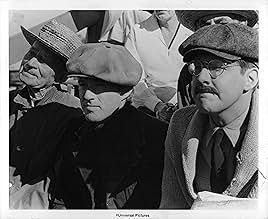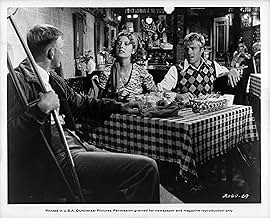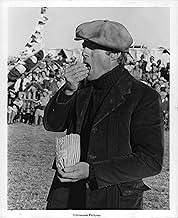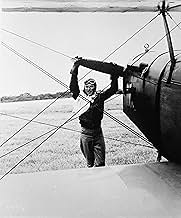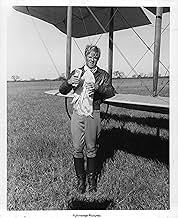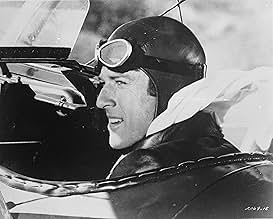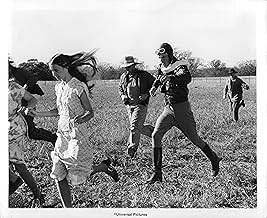Aggiungi una trama nella tua linguaAfter WW1, an ex-pilot takes up barn-storming and chance-meets a former German ace fighter pilot with whom he co-stars in Hollywood war movies depicting aerial dog-fights.After WW1, an ex-pilot takes up barn-storming and chance-meets a former German ace fighter pilot with whom he co-stars in Hollywood war movies depicting aerial dog-fights.After WW1, an ex-pilot takes up barn-storming and chance-meets a former German ace fighter pilot with whom he co-stars in Hollywood war movies depicting aerial dog-fights.
- Regia
- Sceneggiatura
- Star
- Farmer
- (as James Harrell)
Recensioni in evidenza
The casting is excellent - not a single actor is unfit for the part. Redford's looks and charisma, coupled with the fact that while he is still pretty young he does have a few visible age lines, make him perfect for the part of a debonair flyboy, ten years removed from World War I, who is stubbornly resisting the increasing regulation of flying as a profession. Bo Svensen is a great complement as the slightly older, more experienced, and more even-keeled Axel Olsson. Geoffrey Lewis' Newt Potts, Pepper's old squadron commander, represents the future that Pepper is trying to avoid. Ed Herrmann is the embodiment of the "seat of your pants" spirit of the early aircraft producers. Phil Bruns is a convincing "carnival barker" as Doc Dillhoeffer. And the Swedish actor Bo Brundin puts in a great turn as Ernst Kessler, German fighter ace turned barnstormer, who has long since realized that the bravery and chivalry he found in the air (both among comrades and opponents) is rarely found on the ground.
Kessler is based on Ernst Udet, the second-highest scoring German ace of WWI. Udet barnstormed after the war, had a shortened version of "Lola" painted on his Fokker D-VII, and had a fight similar to the epic battle that is an important subplot in the movie. Thus it is a nice touch that Udet is shown in the opening photo montage. (It's also good that no sequel was made - I'd hate to see the Kessler character return to Germany, join Hitler's Luftwaffe and commit suicide.)
This is also notable, on a personal level, as the first place I ever saw Susan Sarandon. I've been a fan ever since. Hell, she still looks great.
The flying sequences are magnificent. There's no CGI here, folks. These are real aircraft - beautiful replicas of Curtiss Jennies, Standard E-4's, and of course the Sopwith Camel and Fokker Triplane (plus a few others) - doing real stunt flying. The talented stunt pilots are credited under the umbrella of Tallmantz Aviation, which I'm guessing was formed by legendary stunt pilots Frank Tallman and Paul Mantz. Tallman himself flew in this film (and died in a crash three years later; Mantz died making "Flight of the Phoenix," another of my favorite flight movies, in 1965.) And the climactic sequence, while it may seem unlikely to some, is actually based (perhaps loosely) on a similar incident that occurred during the filming of either "Hells' Angels" or "Wings" in the late 1920's. The only possible anachronism that I can spot is Kessler's stunt plane, which looks a little too advanced for 1928. But I could be wrong there.
Beautiful aircraft, great flying sequences, fine acting, and even a real plot - what more could you want?
Redford plays the "The Great Waldo Pepper" as he barnstorms from place to place in the early 1900s. You see some wonderful bi-planes and the interesting characters who flew them. The most flamboyant person in this story is "Axel Olsson," played by Bo Svenson. He and Redford are intense competitors and the competition between the two is fun to witness, especially with humor thrown into the mix.
This film is noted for sporting a very young and beautiful Susan Sarandon who makes a very memorable exit from the film! Except for an excessive amount of usages of the Lord's name in vain, this would have been an excellent family film. Other actors whose names you might recognize in here are Edward Herrman, Georffrey Lewis and Margot Kidder.
Redford looks heroic and every bit the Ladies Man especially in uniform.
The aerial sequences are terrific with some really risky stunts and shots. Made in 1975, there are no CGI effects - everything is real and raw.
I felt the film to be a little slow at times but it's a film for grown ups so we can take that speed, can't we?
Scott A. Frisina's review on the main page is as good a synopsis as anyone can give - that's how it is - read it then see this excellent film.
Secondly I would really like to know how the idea for this script developed. It looks like the aviation business is a metaphor for the movie industry. I would not be surprised had director and co-scriptwriter George Roy Hill put many personal feelings and experiences into it. Aviation stands for freedom. But even in the title scene the constant fear of being forcefully grounded becomes evident the main character, aviator Waldo Pepper, talks an overawed boy into getting a canister of gas for him with the promise of a free tour above the landing strip. Cute, at first sight, but also curiously grim. It immediately started me wondering how the boy could manage to carry the full canister over the required long distance.
The wish to be free and be able to fly off sets ever more demanding conditions. People get bored with acrobatics, they want to see blood. The artists comply, because they are ambitious but also because they know that it is the only way that allows them to continue. Time moves on and it becomes evident that commercial air service will put an end to the adventurous phase of aviation. Hollywood seems to be the only way out. Acrobats are needed as stunt-men there. The grindhouse routine of the dream factory is not to their liking, but what else can they do? On a set Waldo Pepper meets a famous German flyer he idolizes. Much to his surprise this Erich von Stroheim character is deeply in debt. In the air, I see heroism, chivalry and a spirit of comraderie", rasps the German, but on the ground ..." He just limply shrugs. The final quixotic showdown between Pepper and the German is a natural and very good ending of this surprisingly deep" and rather pessimistic movie that offers far more than nostalgia.
. But the sport survived, and still thrives, people are doing wilder stunts now than back then, so I guess all came out well in the end. I remember going to a Halloween party in a nice sports car, way back then, dressed as the great Waldo pepper, in a flight uniform with scarf, and knowing that my time, at that age, was very similar to his. I related to the movie at that time in other words. . Paul Bannon
Lo sapevi?
- QuizThere are no studio takes in airplanes. All close-ups of actors being airborne were done for real, sometimes with George Roy Hill, a former Marine pilot himself, flying the airplane while directing. Scenes with Robert Redford and Bo Svenson climbing out on the wing were done without any security harness or parachutes.
- BlooperWhen Ezra and Waldo drive up to the farmhouse in Ezra's pick-up it is very obvious that the truck looks far too old for the 1920's time frame of the movie. In the late 1920's that truck would have been new or nearly new. Instead, it is obviously 40 or 50 years old (which is just about exactly the age it would have been when the movie was released in 1975).
- Citazioni
Dillhoefer: Now, here's what we do. We put her up on the wing...
Duke: And she'll fake being afraid...
Dillhoefer: Right.
Duke: And the wind will blow her clothes off!
Dillhoefer: Yes! Yes!
Waldo Pepper: Wait! Why would the wind blow her clothes off? When I'm wing-walking, the wind doesn't blow MY clothes off.
Dillhoefer: Fool! Nobody wants to come and see YOU with YOUR clothes off!
- ConnessioniFeatured in Collo d'acciaio (1978)
I più visti
- How long is The Great Waldo Pepper?Powered by Alexa
Dettagli
Botteghino
- Budget
- 5.000.000 USD (previsto)
- Lordo Stati Uniti e Canada
- 20.642.922 USD
- Lordo in tutto il mondo
- 20.642.922 USD
- Tempo di esecuzione1 ora 47 minuti
- Colore
- Proporzioni
- 2.35 : 1
Contribuisci a questa pagina




